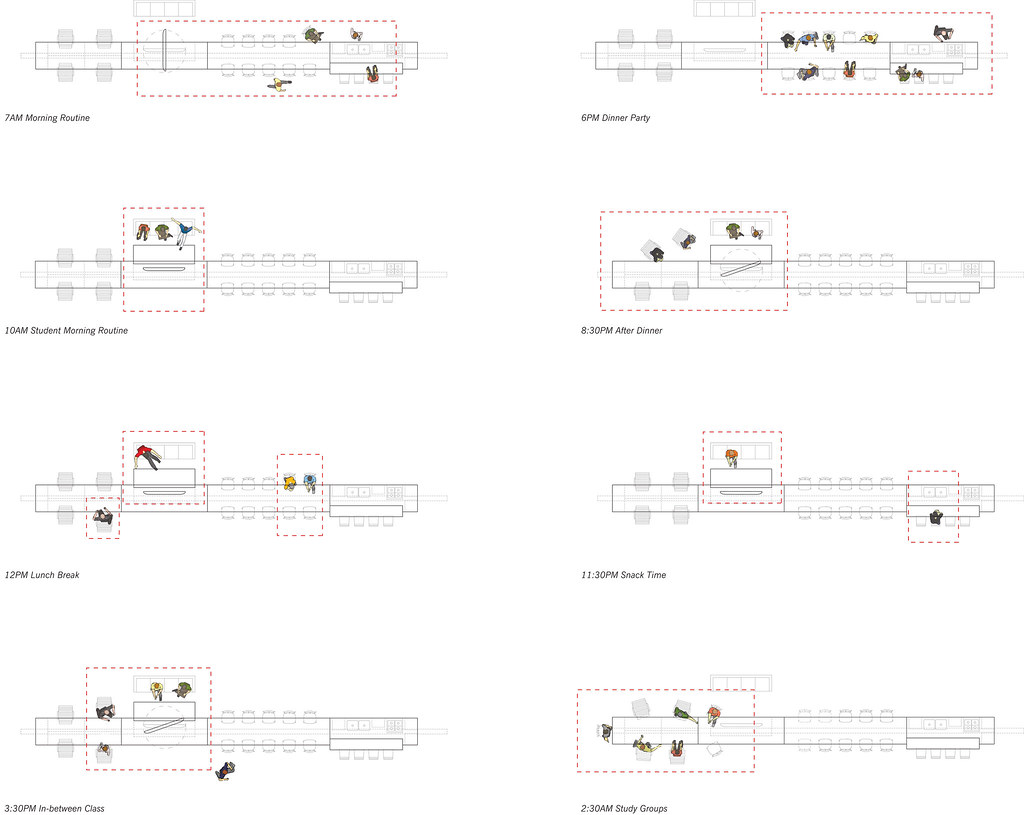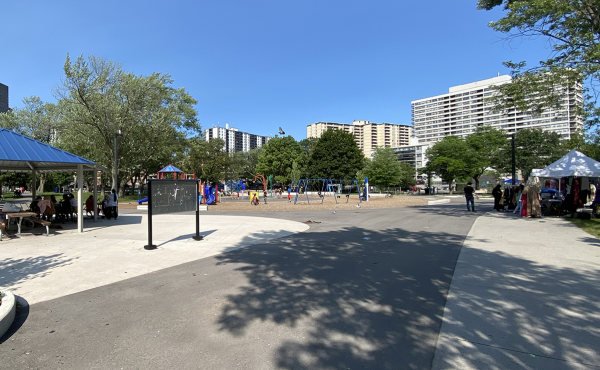
EDITOR: This is the second post in our series looking at the laneway housing projects created in a University of Toronto Architecture Faculty’s Laneway Housing studio led by Brigitte Shim & Don Chong. This work and text is by Christopher Chan, an architecture student at U of T.
The Kensington-Chinatown neighbourhood houses many students, the majority of which attend the University of Toronto and OCAD. This demand for student housing results in a concentration of “student -slums”: houses that are maximized into dormitory-style rooms at the expense of traditional social living space and overall housing quality.
The idea behind this project is to design a shared living situation. It is positioned against the proliferation of the less desirable “student slum” housing type and suggests a mix of families and students for the neighbourhood instead. The strategy is to utilize the laneway as the primary street front and balance the privacy of the bedrooms with a flexible living room.



The laneway addition is to an attached brick house on a corner lot. It accommodates four students while maintaining the existing family house on the site. The sleeping areas for the students are separated from the main house by a common ground-floor living area, which runs parallel to a wall garden. A long table anchors all activities in this shared living space and supports the communal life of the students and the family throughout the day.

While the existing entrance is maintained at the traditional front of the house, the expansion repositions the main entrance towards the laneway. The wall garden becomes part of the interior living space when the glass doors are left open in warmer weather. In colder months, the wall garden is experienced as a passageway leading from the laneway into the living room.





7 comments
Toronto has continually blocked Ms. Shim’s tireless efforts to help them with their own desire to increase density. In the meantime Vancouver, Calgary, etc… have picked up on it and used her brilliant work for their own good.
Just a nitpick regarding the title of the article. While the official neighbourhood name is “Kensington-Chinatown”, few would consider Baldwin and Huron – indeed any address east of Spadina – to be in Kensington Market.
I don’t know — a few people I know who live east of Spadina consider it Kensington. The spirit of a place trumps whatever official borders we might have, IMHO.
i disagree, that area is much more baldwin village than kensington. if huron and baldwin is in kensington, then so is spadina, the lcbo and grossmans. f you told someone to meet you at grossman’s in kensington people would get lost looking for it. i’d say that kensington doesn’t even include the shops on the west side of spadina, thats just spadina.
I agree with Nathan. I’d add three points:
1. City staff in Toronto don’t have the benefit of an official plan that promotes laneway intensification,
2. Citizens don’t have a building permit process that recognizes good design, which I think is essential for dealing with neighbour’s concerns about crowding, light and views
3. We mostly don’t have the connections for new houses (water/sewer) in back alleys, like Vancouver does.
We could address these issues, but we haven’t had anyone champion laneway building in a big way on a political level.
It’s really unfortunate that the city of Toronto is not championing laneway housing because it can do so much for people and the city in general. Property owners can get extra value for what they own, Torontonians in general can get access to more affordable housing in popular and attractive neighbourhoods, and the city gets increased density and greater tax revenue without the kind of high-rise development that can destabilize an established neighbourhood. Some Toronto laneways are decaying and the site of property crime and dumping; laneway housing could revitalize laneways and make the city more attractive and vibrant. While city bureaucrats fail to embrace this progressive idea, the U of T and a private partner are planning on building a high-rise tower of 24-32 storeys on College which will be completely out of place and shadow the neighbourhood to the south discussed in this article. It may also promote more such development in an area with an attractive and historic low-rise and mid-rise built form.
I also do not consider east of Spadina as Kensington. I was born and raised in Toronto, that specific area south and East was always called Chinatown , Huron, Henry St. enchroaching on Dundas, Grange area. differentiated earlier by the Jewish district at Spadina /College, called Kensington which is, Nassau, Baldwin, Global Cheese, formerly Max Bluesteins on Kensington I think, near where the old synogues is, I worked as a Community worker, later Housing worker at the mission on Spadina. HOWEVER I think anything to help with housing in the University area would be brilliant. Also building Up is creative. Good usage of space. It guess it could be considered FRINGE Kensington. Wish I had money to help , my job was keeping guys from being evicted to the street, always wrestling with SRO. Single room occupancy. Students must pay 600. for a grotty student room . Hard to keep your mind on your studies wondering where your rent is coming from,eating Kraft dinner and Mr. Noodle soup eh.
B.C